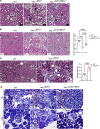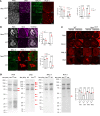Severe kidney dysfunction in sialidosis mice reveals an essential role for neuraminidase 1 in reabsorption
- PMID: 37698928
- PMCID: PMC10619504
- DOI: 10.1172/jci.insight.166470
Severe kidney dysfunction in sialidosis mice reveals an essential role for neuraminidase 1 in reabsorption
Abstract
Sialidosis is an ultra-rare multisystemic lysosomal disease caused by mutations in the neuraminidase 1 (NEU1) gene. The severe type II form of the disease manifests with a prenatal/infantile or juvenile onset, bone abnormalities, severe neuropathology, and visceromegaly. A subset of these patients present with nephrosialidosis, characterized by abrupt onset of fulminant glomerular nephropathy. We studied the pathophysiological mechanism of the disease in 2 NEU1-deficient mouse models, a constitutive Neu1-knockout, Neu1ΔEx3, and a conditional phagocyte-specific knockout, Neu1Cx3cr1ΔEx3. Mice of both strains exhibited terminal urinary retention and severe kidney damage with elevated urinary albumin levels, loss of nephrons, renal fibrosis, presence of storage vacuoles, and dysmorphic mitochondria in the intraglomerular and tubular cells. Glycoprotein sialylation in glomeruli, proximal distal tubules, and distal tubules was drastically increased, including that of an endocytic reabsorption receptor megalin. The pool of megalin bearing O-linked glycans with terminal galactose residues, essential for protein targeting and activity, was reduced to below detection levels. Megalin levels were severely reduced, and the protein was directed to lysosomes instead of the apical membrane. Together, our results demonstrated that desialylation by NEU1 plays a crucial role in processing and cellular trafficking of megalin and that NEU1 deficiency in sialidosis impairs megalin-mediated protein reabsorption.
Keywords: Chronic kidney disease; Genetics; Glycobiology; Lysosomes; Nephrology.
Conflict of interest statement
Figures







Similar articles
-
Renal phenotypic investigations of megalin-deficient patients: novel insights into tubular proteinuria and albumin filtration.Nephrol Dial Transplant. 2013 Mar;28(3):585-91. doi: 10.1093/ndt/gfs462. Epub 2012 Oct 9. Nephrol Dial Transplant. 2013. PMID: 23048173
-
Modeling Sialidosis with Neural Precursor Cells Derived from Patient-Derived Induced Pluripotent Stem Cells.Int J Mol Sci. 2021 Apr 22;22(9):4386. doi: 10.3390/ijms22094386. Int J Mol Sci. 2021. PMID: 33922276 Free PMC article.
-
Type I sialidosis, a normosomatic lysosomal disease, in the differential diagnosis of late-onset ataxia and myoclonus: An overview.Mol Genet Metab. 2020 Feb;129(2):47-58. doi: 10.1016/j.ymgme.2019.09.005. Epub 2019 Oct 31. Mol Genet Metab. 2020. PMID: 31711734 Review.
-
Increase of Total Nephron Albumin Filtration and Reabsorption in Diabetic Nephropathy.J Am Soc Nephrol. 2017 Jan;28(1):278-289. doi: 10.1681/ASN.2015101168. Epub 2016 Jul 6. J Am Soc Nephrol. 2017. PMID: 27382987 Free PMC article.
-
Sialidosis type 1 in a Turkish family: a case report and review of literatures.J Pediatr Endocrinol Metab. 2024 Dec 30;38(2):176-186. doi: 10.1515/jpem-2024-0468. Print 2025 Feb 25. J Pediatr Endocrinol Metab. 2024. PMID: 39733340
Cited by
-
Neu1 deficiency and fibrotic lymph node microenvironment lead to imbalance in M1/M2 macrophage polarization.Front Immunol. 2024 Sep 13;15:1462853. doi: 10.3389/fimmu.2024.1462853. eCollection 2024. Front Immunol. 2024. PMID: 39346907 Free PMC article.
-
Cathepsin B inhibition blocks amyloidogenesis in the mouse models of neurological lysosomal diseases MPS IIIC and sialidosis.Mol Ther Methods Clin Dev. 2025 Feb 11;33(1):101432. doi: 10.1016/j.omtm.2025.101432. eCollection 2025 Mar 13. Mol Ther Methods Clin Dev. 2025. PMID: 40092638 Free PMC article.
-
Neuraminidase-1 (NEU1): Biological Roles and Therapeutic Relevance in Human Disease.Curr Issues Mol Biol. 2024 Jul 26;46(8):8031-8052. doi: 10.3390/cimb46080475. Curr Issues Mol Biol. 2024. PMID: 39194692 Free PMC article. Review.
References
Publication types
MeSH terms
Substances
Grants and funding
LinkOut - more resources
Full Text Sources
Medical
Molecular Biology Databases

